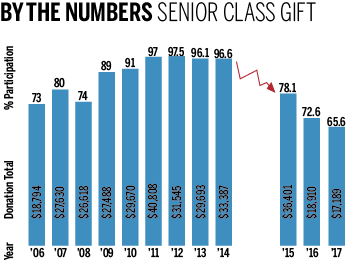
Participation in this year’s senior class gift was 65.6 percent, a 7 percent drop from last year and the lowest rate of participation on record, according to data available online.
Established in 1997, the senior class gift encourages seniors to be active postgraduation benefactors by introducing them to the donation process. But participation has plummeted in recent years: In 2015, amid an active boycott over the University’s mental health resources, the number of seniors donating dropped from about 100 percent of the class, where the figure had remained for four years, to 78.1 percent. This number declined again in 2016 before hitting a new low this year.
By the fundraising initiative’s conclusion on Wednesday, the Office of Development had raised $17,189.88 during this year’s three-week campaign — a slight dip from the $18,910.38 donated last year, and far lower than pre-2015 figures, which traditionally hovered around $30,000.
Although there was no active boycott last year, some students at the time attributed the drop to a general sense of dissatisfaction among seniors. Still, it remains unclear why the participation rate fell below 70 percent this year.
“I confess that I don’t know why the senior gift participation rate is lower than in past years,” Yale College Dean Jonathan Holloway said. “I think it is easy to draw connections between last year’s challenges and giving, but I’m just not certain if that can capture all aspects of why students have decided to participate or not. There are a lot of variables at play that might explain different behavior. I don’t know enough about the various factors to draw a confident, explanatory conclusion.”
But some students suggested that the drop in donations may be indicative of lingering disillusionment with the University, given controversies surrounding Yale policy over the past couple of years.
“My sense is that a lot of people are frustrated with the pace of change here and feel that the University has not been transparent with them about some of its decision-making processes — a glaring example from last year would be the naming of Benjamin Franklin College,” said Emily Patton ’17. “I’m sure that some are also reluctant to be included in a statistic — the participation rate — that in some way functions as a stand-in approval rating.”
Other seniors interviewed said there was a lack of awareness about this year’s senior class gift campaign, suggesting that there was insufficient outreach from campaign leaders and residential co-chairs tasked with spreading awareness within their residential colleges.
Claire Williamson ’17, one of two campaign co-chairs in Jonathan Edwards College said that ultimately, student participation was dependent on this outreach.
Indeed, contributions and participation varied significantly by college. Jonathan Edwards raised the most money with $2,034, whereas Timothy Dwight College came in last with only $936. Davenport College’s participation rate was 81.1 percent, while the participation rate in Timothy Dwight, Ezra Stiles and Grace Hopper colleges were all below 55 percent.
One potential reason for the drop in contributions in Timothy Dwight, Williamson said, is that recruited college co-chairs and other appointed students did not have enough time to reach out to students. Claire Grishaw Jones ’17 said more people would have donated had they known more about the campaign when it began three weeks ago.
During the donation process, students were able to donate to one of six alumni fund designations including financial aid and undergraduate life. A large percentage of students chose to donate specifically to financial aid resources, Williamson said, but she noted that some students may have had concerns about how money would be allocated within specific designations.
Jones, who contributed to the financial aid designation, said she thinks the dampened enthusiasm for the fundraising campaign reflects a lack of willingness to support the administration. Jones said she was disillusioned with power structures and almost did not donate until she discovered the gift designation function.
And Mimi Pham ’17 said some seniors did not donate to send a political statement to the Yale administration.
“In conversations that I’ve had with students, they’ve said things like ‘I really disapprove of the student income contribution, I won’t donate until it changes,’” Pham said. “Seniors think that they have the ability to use ‘not-donating’ to send a message to the administration. Our class knows the power of protests [and] student activism.”
The Alumni Fund was founded in 1890 to raise funds for Yale College.







